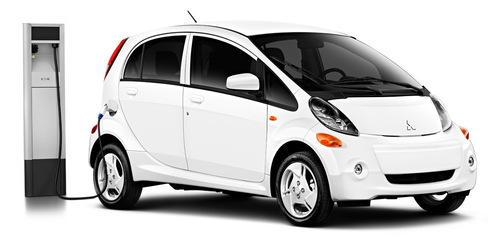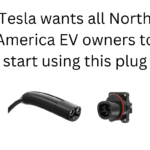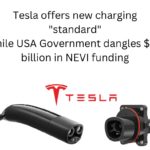A somewhat surprising is that fast charging (for electric cars) can reduce the cost of electric cars. Because electric car cost is a major factor delaying electric car adoption, if fast charging support would allow a cheaper electric car then it’s important to get fast charging infrastructure out there as quickly as possible. That is, if ones goal is to get a high rate of electric car adoption, but as we’ve seen in the past there’s some hints that perhaps maybe the car companies aren’t as keen on getting electric cars on the market.
In any case my previous post (CHAdeMO and SAE DC Fast Charging adoption possibilities – EV adoption prospects are hanging in the balance) went over a Webinar just conducted by Navigent Research, in which they claimed that fast charging can reduce the electric car purchase price. This seemed important enough to explore in its own post … so here goes.
The concept is pretty straightforward really … If the battery pack is sized big enough to satisfy typical daily driving (80ish mile range is more than enough) the electric car could be used for all but the infrequent long trips. That is, most people are driving 40ish miles or less a day, and only occasionally take longer trips.
The cheaper the battery pack, the cheaper is the electric car.
That’s it, really. If you want the price to be low enough for the car to be popular, make the battery pack small.
The Mitsubishi i-MiEV shown above implements that combination rather well. The 2013 Nissan Leaf doesn’t quite do it, but the entry level MSRP is low enough ($28,800) that it is within the price range of the hybrid cars![]() . The Chevy Spark EV that’s due to go on sale this summer also implements the idea, but with the SAE DC Fast Charging system.
. The Chevy Spark EV that’s due to go on sale this summer also implements the idea, but with the SAE DC Fast Charging system.
At the other end of the spectrum we have the Tesla Model S with a huge battery pack and a big price. The battery pack provides far more driving range than anybody could seriously want, but it’s sized to fit the “road trip” mentality.
Where does fast charging fit in? Its’ primary role is to aid an EV driver in taking longer trips. The big question is how often does one take medium-range or long-range trips?
The owner of an inexpensive shorter-range EV could use it for daily driving around town quite easily. But what do they do for a medium-range trip? Do they stop for a multi-hour charging session halfway through the trip? That’s unlikely to be tenable. Experience in Japan where they have a mature fast charging network says that public level 2 charging is not a good combination![]() , and instead public fast charging is the preferred combination. Why? The multi-hour wait for a recharge is flat-out incompatible with road trips, whereas the 30 minute recharge time for fast charging is closer to the road trip scenario.
, and instead public fast charging is the preferred combination. Why? The multi-hour wait for a recharge is flat-out incompatible with road trips, whereas the 30 minute recharge time for fast charging is closer to the road trip scenario.
If the driving pattern for a specific person is primarily short-range trips with occasional medium-range trips, then the small EV with fast charger will work wonderfully.
For proper road trips – 600+ miles a day – this combination of small pack and fast charger won’t be suitable. That’s because you’d be stopping frequently for fast charges throughout the day and even though each is only 1/2 hour they’ll add up.
The Tesla Model S is sized to handle road trips, and with the Supercharger network the Model S owner can practically do a 600+ miles a day road trip. Several in fact have already done so. This is because of the combination of large battery pack with fast charging. But it comes at a high price.
The theory is that less expensive car is automatically going to be more popular. We don’t know that for sure because the experiment is still underway. The sales for electrified cars are growing (March 2013 electric car sales best ever according to EDTA, led by Leaf and Model S sales![]() ) with the Leaf and Model S are leading the pack. That means these two models .. inexpensive car with fast charger .. expensive car with fast charger .. are in the lead, but it’s still too early to tell much. The 2013 Leaf just began sales in the U.S. so we don’t know what its’ future holds, likewise the Model S is still at the beginning of its story and we can’t tell much for certain about its future.
) with the Leaf and Model S are leading the pack. That means these two models .. inexpensive car with fast charger .. expensive car with fast charger .. are in the lead, but it’s still too early to tell much. The 2013 Leaf just began sales in the U.S. so we don’t know what its’ future holds, likewise the Model S is still at the beginning of its story and we can’t tell much for certain about its future.
- Highway design could decrease death and injury risk, if “we” chose smarter designs - March 28, 2015
- GM really did trademark “range anxiety”, only later to abandon that mark - March 25, 2015
- US Government releases new regulations on hydraulic fracturing, that some call “toothless” - March 20, 2015
- Tesla Motors magic pill to solve range anxiety doesn’t quite instill range confidence - March 19, 2015
- Update on Galena IL oil train – 21 cars involved, which were the supposedly safer CP1232 design - March 7, 2015
- Another oil bomb train – why are they shipping crude oil by train? – Symptoms of fossil fuel addiction - March 6, 2015
- Chevron relinquishes fracking in Romania, as part of broader pull-out from Eastern European fracking operations - February 22, 2015
- Answer anti- electric car articles with truth and pride – truth outshines all distortions - February 19, 2015
- Apple taking big risk on developing a car? Please, Apple, don’t go there! - February 16, 2015
- Toyota, Nissan, Honda working on Japanese fuel cell infrastructure for Japanese government - February 12, 2015
















